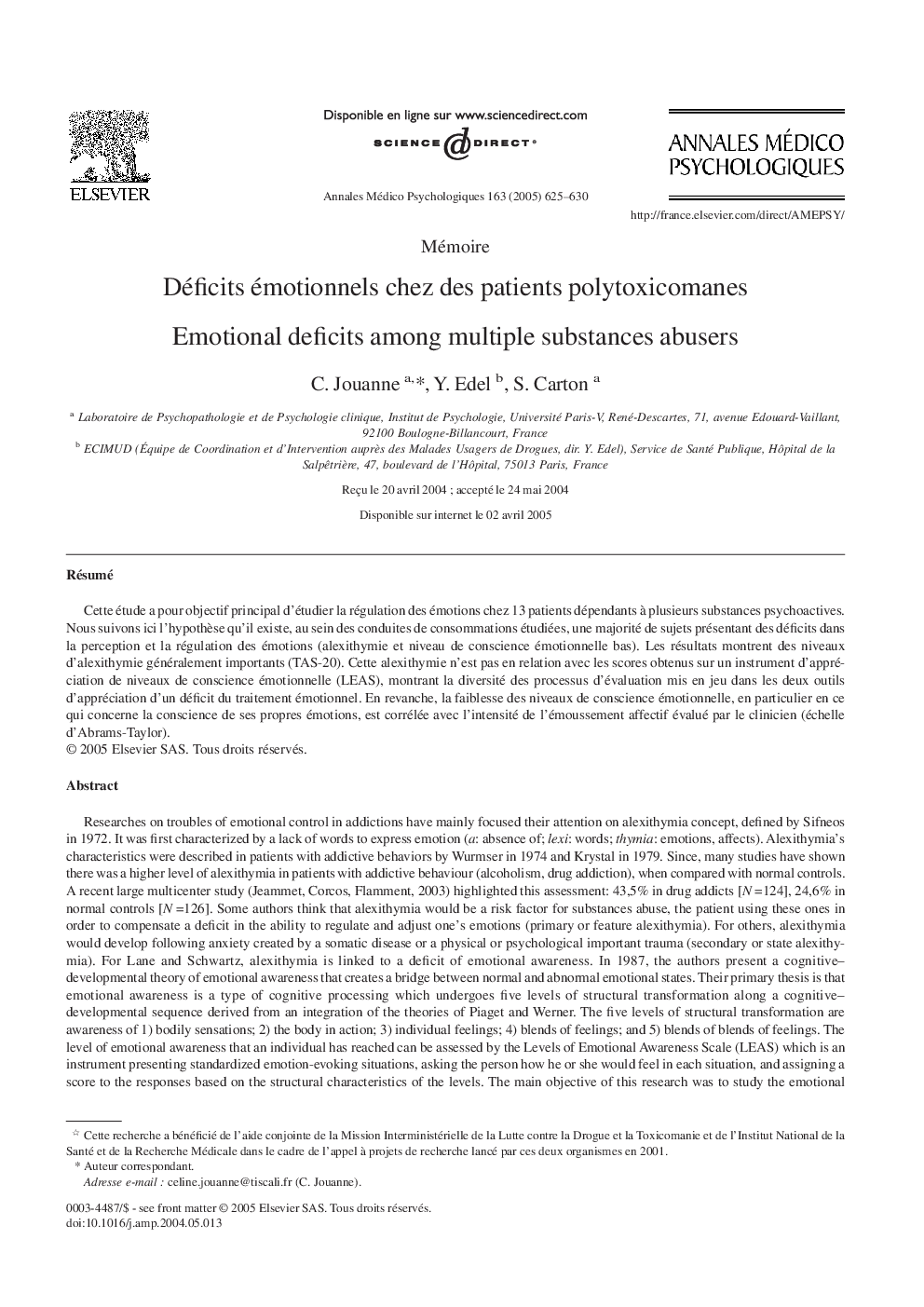| کد مقاله | کد نشریه | سال انتشار | مقاله انگلیسی | نسخه تمام متن |
|---|---|---|---|---|
| 10296933 | 534604 | 2005 | 6 صفحه PDF | دانلود رایگان |
عنوان انگلیسی مقاله ISI
Déficits émotionnels chez des patients polytoxicomanes
دانلود مقاله + سفارش ترجمه
دانلود مقاله ISI انگلیسی
رایگان برای ایرانیان
کلمات کلیدی
موضوعات مرتبط
علوم پزشکی و سلامت
پزشکی و دندانپزشکی
روانپزشکی و بهداشت روانی
پیش نمایش صفحه اول مقاله

چکیده انگلیسی
Researches on troubles of emotional control in addictions have mainly focused their attention on alexithymia concept, defined by Sifneos in 1972. It was first characterized by a lack of words to express emotion (a: absence of; lexi: words; thymia: emotions, affects). Alexithymia's characteristics were described in patients with addictive behaviors by Wurmser in 1974 and Krystal in 1979. Since, many studies have shown there was a higher level of alexithymia in patients with addictive behaviour (alcoholism, drug addiction), when compared with normal controls. A recent large multicenter study (Jeammet, Corcos, Flamment, 2003) highlighted this assessment: 43,5% in drug addicts [N =124], 24,6% in normal controls [N =126]. Some authors think that alexithymia would be a risk factor for substances abuse, the patient using these ones in order to compensate a deficit in the ability to regulate and adjust one's emotions (primary or feature alexithymia). For others, alexithymia would develop following anxiety created by a somatic disease or a physical or psychological important trauma (secondary or state alexithymia). For Lane and Schwartz, alexithymia is linked to a deficit of emotional awareness. In 1987, the authors present a cognitive-developmental theory of emotional awareness that creates a bridge between normal and abnormal emotional states. Their primary thesis is that emotional awareness is a type of cognitive processing which undergoes five levels of structural transformation along a cognitive-developmental sequence derived from an integration of the theories of Piaget and Werner. The five levels of structural transformation are awareness of 1) bodily sensations; 2) the body in action; 3) individual feelings; 4) blends of feelings; and 5) blends of blends of feelings. The level of emotional awareness that an individual has reached can be assessed by the Levels of Emotional Awareness Scale (LEAS) which is an instrument presenting standardized emotion-evoking situations, asking the person how he or she would feel in each situation, and assigning a score to the responses based on the structural characteristics of the levels. The main objective of this research was to study the emotional treatment in 13 patients with multiple addictive behaviors according to DSM-IV criteria (drug addiction + alcoholism + smoking) and with a substitution treatment (methadone, Subutex®). Those subjects were aged between 23 and 42 years. Our hypothesis was that subjects would present deficits in perception and regulation of emotions (alexithymia and low level of emotional awareness). Four rating scales were used to assess the emotional semiology and the possible presence of depression and/or anxiety: the Hamilton depression scale, 17 items version; the Tyrer's brief scale for anxiety; the Jouvent's rating scale of depressive mood and the Abrams-Taylor's scale of emotional blunting. Alexithymia was evaluated with the Toronto Alexithymia Scale, 20 items version (TAS-20), and the emotional awareness with the Levels of Emotional Awareness Scale (LEAS). Our results showed levels of alexithymia generally important. The prevalence of alexithymia in patients with addictive behaviors was 69% with a mean score to this scale of 57,8 ±11,5, which is above observed mean in the general population (46,2 ±10,52). The mean score to the LEAS was 49,6 ±6,5 and less than the one observed in patients with a depressive mood and normal controls by Berthoz in 2000, and same results were observed for scores « subject » and « other ». For eight patients, the total scores were between 51 and 59, showing a low level of emotional awareness corresponding to the second one, the sensorimotor enactive, in Lane and Schwartz's model. There was no significant correlation between intensity of depressive mood and anxiety (Hamilton's scale and Tyrer's scale) and the different scores of LEAS and TAS-20. On the other hand, there was a negative significant correlation between the score « subject » of LEAS and the intensity of emotional blunting assessed by the Abrams-Taylor's scale (R = -0.589, P <05). Furthermore, there was a tendency for significant correlation between the total score of LEAS and the intensity of emotional blunting (R =-0.543, P <0.10). The total score of TAS-20 was not related to the total score of LEAS. However, there was a positive significant correlation between the mean score of TAS-20 and the score « other » of LEAS (R =0.570, P <0.05). No significant correlation was observed between the three components of alexithymia and the different scores of LEAS. This study has shown troubles in emotions's treatment in a sample of patients with addictive behaviors. Levels of alexithymia were generally important (TAS-20), showing in these patients difficulties to identify and distinguish between feelings and bodily sensations, to describe feelings and presenting an externally-oriented thinking. Furthermore, subjects have a low level of emotional awareness, corresponding to the sensorimotor enactive level. At this level, emotion may be experienced as both a bodily sensation and an action tendency. Curiously, alexithymia is not related to LEAS scores: this may reflect different levels of emotional appraisal processes and consciousness in the two different instruments. However, the emotional deficit, when it is hetero-appraised by the clinician (Abrams-Taylor Scale), is related to weakness in the LEAS scores, in particular concerning awareness of one's own emotions.
ناشر
Database: Elsevier - ScienceDirect (ساینس دایرکت)
Journal: Annales Médico-psychologiques, revue psychiatrique - Volume 163, Issue 8, October 2005, Pages 625-630
Journal: Annales Médico-psychologiques, revue psychiatrique - Volume 163, Issue 8, October 2005, Pages 625-630
نویسندگان
C. Jouanne, Y. Edel, S. Carton,